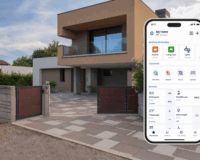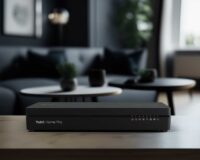It seems that these days almost everything is “smart”. We have smart phones, smart watches, smart TVs and even smart fridges! If you were to search online for Smart Home, you will be absolutely inundated with options.
From speakers to lights, assistants to thermostats, nothing is spared when it comes to today’s tech savvy occupant.
There are also a large number of different technologies in the world of Smart Homes and while most of them work in similar ways, we believe that there is one which is superior to the others. It has been in action around the world for over 20 years making it one of the most established wireless smart home technologies in existence today. Allow us to introduce you to Z-Wave.
Z-wave is the absolute world standard wireless technology which allows your home electronics to talk to one another, and with you, all via remote control. It uses very simple and low powered radio waves which are designed to easily pass through walls, floors, ceilings and fittings. Different regions in the world use their own unique radio frequencies and for us here in Australia and New Zealand, it is the 921MHz band. This makes Z-Wave completely unique and differentiates it from the busy radio frequency bands of Bluetooth and WiFi (2.4GHz & 5GHz). A quiet radio frequency band means that information passed along it will not be interrupted and are allowed to quickly and easily over longer distances.
Another benefit of being completely wireless is that Z-Wave brings together all of the electronics in your home into an integrated and easy to program network without having to run new cables all around your home. Devices which are already Z-Wave enabled can easily be included into your network, and non Z-Wave devices can be “made smart” by attaching a Z-Wave module to them. This means that household appliances, lights, climate control systems, roller blinds and even plumbing can be brought into your wireless network and included into your Smart Home using Z-Wave technology. All you need is the necessary Z-Wave modules and a Z-Wave gateway controller. Of course, being wireless also means you can often monitor, control and automate your home from any internet connected PC, smartphone or tablet regardless of whether you’re at home or on the other side of the globe.

Z-Wave is Scalable
Z-Wave networks are special in that they operate as “mesh networks”. What this means is that certain devices help repeat the network signal and therefore strengthen the integrity of the network. Devices which are constantly powered, such as light switches, range extenders and blind controllers bounce messages across to one another. This allows for strong and quick communication around even the biggest homes, knocking out obstacles and wireless dead spots. Another great feature is that Z-Wave devices are interoperable, meaning that different products from different brands will work with one another. This also allows for backwards compatibility meaning that devices purchased in the past will still work with devices purchased today and in the future.

Z-Wave is Secure
Directly built into the microchip is the latest in encryption and digital safety. There are two types of built in security available today and they are AES128 and S2 level encryption. This is the same level of security used by online banking platforms and ensures that outside disruption is not a concern. Every gateway controller also has it’s own unique Home ID which it then shares with other devices within it’s network. These ID numbers allow for each device to be uniquely identified when it is added to your network and means that only your gateway can control it. Even if your neighbour has a Z-Wave network in their home, your devices are safe and secure, as are your neighbours!

Z-Wave is Affordable
With most devices being so simple in their design and execution, the cost of setting up and growing a Z-Wave network are generally quite low. We’ve already mentioned that Z-Wave networks are scalable. This allows you to start off with a gateway and few devices, then when it is feasible for you, grow your network to include more devices and aspects of your home. Installation does not require any extra wiring or complex programming and can quite often be done by a DIY enthusiast. This of course does not include any devices which need to be connected to the mains power supply, which do require a qualified and registered Electrician to be safely installed. A robust and reliable Z-Wave network is achievable at a mere fraction of the cost of wired solutions.
For a more detailed description of exactly what a Z-Wave network can accomplish in your home, please refer to the other articles on our Solutions page. You can also find a large variety of devices in our Shop.
Frequently Asked Questions
How does a Z-Wave Home Automation system work?
Each Z-Wave device such as a lamp, light switch/dimmer, thermostat, sensor, garage door opener, pool control, etc. has an individual highly protected security code, selected from more than 4 billion options. When you add a new device to the Central Home controller, it learns what its code is and includes the device into the Home network. Then when you press an appropriate button, the Central Home controller sends a signal to the device telling it what to do. (For more details, see Z-Wave wireless technology). Then the device performs the requested action (e.g. dims a light to 50%) and immediately sends a confirmation of the current status (in this example the light is dimmed to 50%) back to the Central Home Controller. You can manage your Z-Wave devices via multiple interfaces such us IPhone, IPad, Android, PC etc.
What kinds of devices can be controlled within the Z-Wave network?
Nearly anything that you can control by hand can be controlled using Z-Wave technology. Some examples include lights (both on/off and lighting levels), heaters, garage doors, electronic entry systems, motion sensors, motorized blinds, locks, motorized skylights, motorized windows, AC split systems and fire places with IR interface.
How do I get a Z-Wave Home Automation system started and what do I need to start?
You can purchase a basic kit (devices and Central Home controller) to satisfy your immediate need, and then add more devices as your desire (and budget) allow. A Z-Wave system is designed to be easy to expand.
How many devices can I have on my network?
A single Z-Wave network supports up to 232 devices. Multiple Z-Wave networks can be combined via gateways.
Is it difficult to install and can you help me?
Not at all. Some devices, such as Z-Wave lamp controllers, simply plug into existing electrical outlets. You use them the same way as you use e.g. a timer. Many other Z-Wave devices are just battery operated like e.g. sensors, locks and thermostat. Their installation is easy and safe to do. There are however some devices e.g. 230V inwall switches and dimmers which must be installed for you by a certified electrician in Australia. There is more and more certified electricians in Australia who have experience with installing Z-Wave 230V devices.They cover most locations in Australia and would be happy to install your Z-Wave system for you. Z-Wave devices come with detailed manuals for installation, configuration and use.
What kinds of devices can I use to control my Z-Wave System?
Currently, you can choose from a handheld remote control, Apple devices (iPhone, iPod, iPad), Android (e.g. smart phones), PC or Internet interface.
Does Z-Wave require a central controller?
Yes and No. For the simple Home Automation installations you’ll only need a hand held Z-Wave remote control. For the more complex solutions you’ll need a Z-Wave Central Home controller or Z-Wave Gateway which will perform advance functions while the hand held acts as a secondary controller.
How difficult is it to program a Z-Wave system?
Not very. If you can set-up your smart phone or television, you can most likely program a Z-Wave system.
How do I know whether the desired action has occurred?
You will see a status change or receive a message on the controlling device informing you that the action has been completed. This status change / message will appear when the device being controlled sends a completion signal. It is part of the Z-Wave protocol to receive confirmation of any status changes undergone by a controlled device (e.g. a switch ON or OFF, dimmer 40%, heating ON, etc.)
Can I control multiple devices at once?
Yes. You can control any combination of devices with a single push of a button, and even set scenes using multiple types of devices.
What are scenes?
Scenes in Home Automation are a pre-set combination of actions that occur at the touch of a single button. Lighting scenes have gained popularity in recent years, but Z-Wave goes well beyond that. For example, you can create a scene that closes the blinds at sundown, adjusts the temperature, turns on inside lights to a pre-set level, turns on the television to the evening news, activates an outdoor motion sensor, and locks the doors. All from your Central Home controller.
Can I use Z-Wave with outdoor devices?
Yes, providing they remain within range of the controllers. Also, you have to ensure that all electric parts (wires and devices) are properly protected from any environmental factors (eg. Rain).
I have a large, sprawling home. Will Z-Wave work here?
It is very likely. Because Z-wave uses routing technology, one Z-Wave device will pass the signal along to another until the final destination is reached. This relay system greatly extends its range. The final range, of course, depends on how many devices you have and the construction of your home. The more walls or other obstacles a signal has to pass through, the shorter its effective range will be and as a result more devices working as repeaters will be required.
Is Z-Wave expensive?
Although a Z-Wave light switch may cost a little more than a normal light switch, it is still far less expensive than other home control technologies, and far more flexible. A typical homeowner can outfit a house with a basic, entry level Z-Wave system for less than $600.






